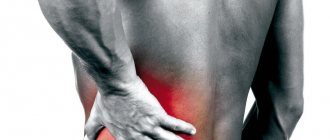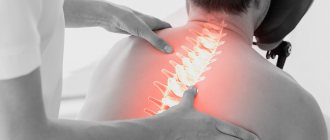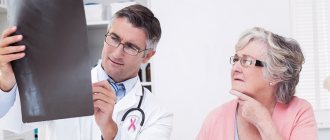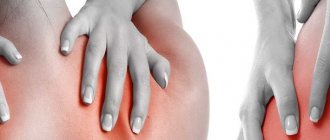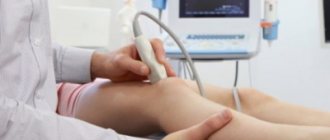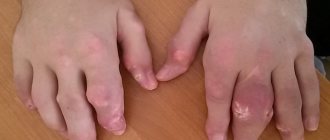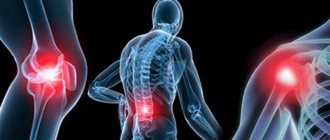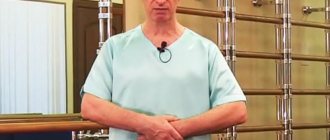If your lower back, back or neck hurts, it’s difficult to straighten up, your spine crunches – many people automatically diagnose themselves: “of course – osteochondrosis!” The reasons for this “sickness” seem to be extremely clear: we live in the twenty-first century, we move little, we don’t eat right...
However, in reality everything is a little more complicated.
Our expert in this field:
Lashch Natalia Yurievna
Neurologist of the highest category, candidate of medical sciences, associate professor. Laureate of the Moscow City Prize in the field of medicine.
Call the doctor Reviews about the doctor
What is it - spinal osteochondrosis? How appropriate is such a diagnosis? And what happens in the spinal column?
In scientific terms, osteochondrosis is a degenerative (that is, leading to premature “aging”, “wear and tear”) disease of the spine (by the way, it can also affect other joints). The pathological process begins with the intervertebral discs and gradually spreads to the vertebrae.
Osteochondrosis of the spine - does such a diagnosis exist?
In English-speaking medicine, this term denotes a completely different group of diseases that have nothing to do with our “native” osteochondrosis. In the International Classification of Diseases, a book that all neurologists should refer to when indicating a diagnosis, there are terms such as “spinal osteochondrosis in adults,” “juvenile spinal osteochondrosis,” and “unspecified spinal osteochondrosis.”
However, sometimes this diagnosis is not made entirely justifiably, when the doctor actually cannot fully understand what is happening to the patient. This term may cover diseases such as:
- Myofascial pain syndrome is a condition in which spasm occurs repeatedly in the same muscles.
- Muscle injuries. After an injury, pain begins to bother you, and after a while it goes away on its own.
- Otolithiasis is a condition in which calcium salt crystals accumulate in the inner ear. They lead to dizziness - sometimes they are mistaken for a manifestation of spinal diseases.
- Headache. They are also often associated with degenerative changes in the cervical spine. In fact, more often they have other reasons.
Visit the neurological center International Clinic Medica24. We can understand the causes of your symptoms and recommend treatment to help manage them.
Take care of yourself, book a consultation now
Message sent!
expect a call, we will contact you shortly
Conservative Treatment Options
To treat neck pain caused by degenerative disc disease, your doctor will usually recommend one or more of the following treatment options:
- Vacation or lifestyle change
. Some activities can be more painful for the neck, such as craning the neck forward when working at a computer. Abstaining or changing certain activities for a few days or weeks usually reduces pain. It is also recommended to maintain good posture (instead of slouching when sitting or bending your neck forward while driving, etc.). Eating healthy foods, staying adequately hydrated, and not smoking are also beneficial for disc health. - Treating pain with medications or injections. Over-the-counter pain relievers such as acetaminophen (eg, Tylenol), ibuprofen (eg, Advil, Motrin), or others may have some effect. If the pain is severe, a stronger pain reliever may be prescribed, such as oral steroids or muscle relaxants (such as Vicodin) or even opiates.
Injections such as facet injections, nerve or epidural blocks. These may involve injecting corticosteroids into a specific structure to reduce local inflammation:
- Caudal epidural injections
- Facet joint injections
- Interlaminar caudal epidural steroid injections
- Transforaminal epidural injections
- Selective nerve root blocks
- Medial branch blocks
- Ice and heat
can be used in the treatment of osteochondrosis of the cervical spine. - Exercise therapy.
Most non-surgical programs for the treatment of osteochondrosis of the cervical spine will include certain exercise programs, both isometric and stretching. The selection of exercises should be carried out by a qualified specialist (physical therapy doctor), since inadequate exercises can lead to a worsening of the condition. In addition, exercises should be selected taking into account the individual characteristics of a particular person. In general, increasing strength and flexibility in the neck can reduce the risk of pain and, to some extent, slow down degenerative changes in the discs. - Manual therapy
. The cervical spine can be manually adjusted by a qualified healthcare professional to improve range of motion and/or reduce pain. Depending on the individual patient's symptoms, physical examination and/or imaging should be performed before manual manipulation of the neck. - Physiotherapy
- Massage
- Acupuncture
- Corseting
Treatment of spinal osteochondrosis
The standard set of treatment measures for exacerbation of the disease looks like this:
- Anti-inflammatory and painkillers. The doctor may prescribe Voltaren, Movalis, ibuprofen and other drugs.
- If the pain is very severe and does not go away , novocaine blockades are used. The doctor, armed with a needle and syringe, injects the anesthetic into special places where it blocks the transmission of pain nerve impulses.
- Physiotherapy procedures help: medicinal electrophoresis with novocaine, ultrasound, ultraviolet irradiation, diadynamic currents.
- If pain forces you to constantly be in nervous tension, medications are prescribed to help you calm down.
- to the area of pain .
- In order to unload the spine, different types of traction are used. The patient can be placed on a special bed with a raised headboard and secured with rings by the armpits. Underwater traction in the pool is also used.
- Your doctor may recommend that you visit a chiropractor or acupuncture sessions.
- During an exacerbation , special orthopedic devices are worn that help relieve the muscles and support the spine - corsets, Shants collar.
When the exacerbation passes, you need to take measures to help prevent a new one. Therapeutic exercises and massage help strengthen the muscles that support the spine. Physiotherapy courses are prescribed. Swimming is good for you. All treatment methods for osteochondrosis have contraindications, they must be used wisely, so self-medication is not the best choice. Visit your doctor.
Sometimes the symptoms of the disease, despite treatment, continue to increase, and the patient’s condition worsens. In this case, the neurologist may raise the question of surgical treatment.
Why should you visit a doctor soon? Firstly, “real” osteochondrosis is not such a harmless disease. Over time, it can make a person disabled if left untreated. Secondly, the symptoms can be caused by the same myofascial pain syndrome - a neurologist will be able to quickly detect the cause of the pain and eliminate it. Visit a specialist at the medical center International Clinic Medica24 - call to make an appointment at any time of the day: +7 (495) 230-00-01.
Take care of yourself, book a consultation now
Message sent!
expect a call, we will contact you shortly
Back pain is a symptom that, according to statistics, more than 90% of people experience at least once in their lives. Most often it is attributed to osteochondrosis. Not all people experiencing pain in the spine go to doctors. Many people treat themselves with medications that can be obtained without a prescription at the pharmacy, or with folk remedies. Sometimes such “treatment” brings temporary relief - but in the meantime the disease can continue to progress and, perhaps, next time the back or lower back will “twist” much more strongly.
An experienced neurologist will be able to correctly assess the symptoms of osteochondrosis, understand their causes and prescribe the correct treatment for osteochondrosis.
Pain, the main manifestation of osteochondrosis, can be more or less successfully combated for a long time with the help of painkillers and anti-inflammatory drugs, and some folk remedies. But this does not solve the main problem; pathological changes in the spine continue to increase. Over time, this is fraught with compression of the spinal cord and the arteries that supply it, and the development of serious neurological complications: severe weakening, even complete loss, of movements and sensitivity, loss of control over the bladder and rectum.
Which doctors should I contact?
Having considered the symptoms, types of disease, diagnostic methods and possible consequences, we will find out where to initially turn.
- A therapist is the first right step. Usually this is a family doctor who sees the family, and he already knows something about the patient’s illnesses and lifestyle. Therefore, it is easier for him to correctly coordinate his further actions. He will determine which doctor to go to next and what tests to take.
- A neurologist is the second correct option (you can skip the first and turn to the second on your own). After the examination and photographs, he may send you for a consultation with a traumatologist, or prescribe treatment on his own. Frequently consults with specialists in other related fields.
- A vertebrologist is the third, or more precisely, the first option, because he is a specialist in diseases of the spine. But it can only be found in large cities at neurology departments or in private offices.
- Traumatologist – if osteochondrosis occurred as a result of injury.
- A physiotherapist - usually one of the above specialists will already refer you to him if necessary.
- Chiropractor - also on the direction of the previous doctor.
- Surgeon - visiting him is indicated when osteochondrosis is extremely advanced and it is impossible to manage with conservative treatment.
- Other, non-traditional doctors who can help with the problem: a hirudotherapist, an osteopath - a chiropractor who deals with problems of the spine.
When doing therapeutic exercises, it is imperative to maintain consistency in exercise to obtain an effective result, forming a muscle corset.
Consultations with a doctor online Taking care of your health is a life priority for everyone. Communicate with doctors online and receive qualified assistance without leaving your home. Try it Please note! The information on this page is provided for informational purposes only. To prescribe treatment, you must consult a doctor.
What symptoms usually manifests itself as spinal osteochondrosis?
A typical manifestation of the disease is pain. As a rule, they are aching, constantly bothering, accompanied by a feeling of numbness, aching in the arms and legs. Typically, pain intensifies during sudden movements, heavy lifting, physical work, sneezing, coughing, and prolonged stay in a monotonous uncomfortable position.
The muscles surrounding the spine respond to pain. Tension arises in them. Because of this, the patient may be in an antalgic position - one in which the pain does not bother him so much. Gradually this leads to curvature of the spine.
Over time, if the disease is not treated, the pain intensifies and becomes excruciating. Other signs of osteochondrosis occur:
- Sensitivity is impaired, a feeling of numbness, tingling, and “crawling” occurs in the arms and legs.
- The muscles of the limbs weaken and decrease in size over time - their atrophy develops.
- With osteochondrosis of the cervical spine, patients complain of headaches, dizziness, tinnitus, “spots” and bright spots before the eyes.
- With thoracic osteochondrosis, pain in the heart is bothersome. The person may experience a sensation “as if a stake had been driven into the chest.”
- If compression of the nerve roots of the spine occurs (for example, during the formation of a herniated disc, bone outgrowths on the vertebrae), severe shooting pains occur.
In some cases, the symptoms of “osteochondrosis” are actually associated with other diseases. In order to receive a reliable diagnosis and correct treatment, contact the neurological center of the International Clinic Medica24.
Take care of yourself, book a consultation now
Message sent!
expect a call, we will contact you shortly
Types of osteochondrosis and symptoms
The disease can be localized in different parts of the body (the back most often suffers), and, based on the concentration of pain and symptoms, several types of the disease are distinguished.
Cervical osteochondrosis
It most often occurs in office workers who spend long periods of time sitting, when the neck remains motionless. It appears like this:
- lumbago radiating to the shoulder blades, arms, and back of the head;
- painful sensations when turning the head and touching the back of the head;
- numbness and swelling of the tongue;
- tingling and goosebumps, often occurring in the neck and arms;
- dizziness;
- insomnia.
Lumbar
The second most common type of this disease. It most often affects people who lift heavy weights, who are engaged in standing work, and who experience excessive stress on the spine. Symptoms:
- lumbar pain, often radiating to the groin, legs, sacrum;
- impaired mobility;
- pins and needles in the legs and loss of sensation;
- lumbago, characterized by lumbago;
- pinching of the sciatic nerve;
- radiculitis.
In advanced conditions, it can lead to dysplastic osteochondrosis, characterized by the growth of osteophytes on the vertebrae.
Thoracic osteochondrosis
A less common, but no less dangerous disease, sometimes accompanied by acute pain. Changes are signaled by symptoms:
- pain, often described as “a stake in the chest”;
- feeling of chest being squeezed “in a vice”;
- shooting, sharp pain in the chest;
- pain when walking;
- pain when breathing.
Other localizations
- Osteochondrosis of the coccyx is rare and occurs more often in women than in men due to the special structure of the pelvis.
- Osteochondrosis of the joints, medically called deforming arthrosis.
- Mixed osteochondrosis, in which not one part of the spine is affected, but several.
Correct treatment of symptoms of spinal osteochondrosis
The key to effective treatment is correct and timely diagnosis. In our clinic, during a neurological examination, a specialist doctor will assess your symptoms and the degree of impairment of certain nervous functions.
With us, you can undergo an examination using new, modern equipment - this will help you understand in detail what is happening to your spinal column, nerve roots, surrounding tissues, and muscles.
Treatment should be directed not just against the symptoms of osteochondrosis. You need to try to eliminate the cause, and if this is not possible, understand how you can most effectively keep the disease under control and prevent it from progressing. The neurologist will draw up the correct treatment program and adjust it taking into account changes in your condition.
If you do not receive treatment for a long time, there may come a time when conservative, non-surgical methods will no longer help, and the question of surgical intervention will arise. Contact a neurologist. Call us now: +7 (495) 230-00-01.
We will call you back
Message sent!
expect a call, we will contact you shortly
In order to defeat the enemy, you need to know him by sight. This is the case with any disease: a careful examination by a doctor, modern instrumental studies and laboratory tests help to establish an accurate diagnosis, understand what is happening in the patient’s body and prescribe effective treatment for osteochondrosis.
The main manifestation of osteochondrosis is back pain, a symptom that can occur with many other diseases. In order to establish the exact cause and cope with it, you need the help of a specialist. We invite you to visit the medical center International Clinic Medica24.
Who treats back pain
A neurologist specializes in treating diseases of the nervous system. Preparing for a consultation with a neurologist involves collecting information on your disease. The doctor will need to provide all the results of the examinations and expert opinions. If at the time of the examination the patient is taking any medications, this must also be reported.
Your doctor will tell you what kind of diagnostics you need to undergo. You may be assigned:
- Gastroscopy
- MSCT of the brain
- MRI of the gallbladder
- Functional diagnostics Electroencephalography (EEG)
- X-ray of the urinary system (excretory urography)
- CT bowel
- X-ray of the mammary glands (mammography)
- CT scan of the lumbar spine
- MSCT of the abdominal aorta
- X-ray of the esophagus
- Scintigraphy of the parathyroid glands
- CT scan of the cervical spine
- Functional diagnostics Electroencephalography (EEG)
- Chest x-ray
- Ultrasound of the mammary glands
- X-ray of the spine
- Ultrasound of the gallbladder
- MSCT of the cervical spine
- Functional diagnostics Rheoencephalography (REG)
- CT bowel
- X-ray of the spine
- X-ray of the spine
- MRI of the lumbosacral spine
- MSCT of the brain
- MRI of the eye orbits and optic nerves
- CT scan of the lumbar spine
- Ultrasound for pregnant women in the 3rd trimester
- MRI of the thoracic region
- Ultrasound of the abdominal organs
- Ultrasound (ultrasound examination)
- X-ray of the spine
- CT scan of the chest
- X-ray
- CT scan of the thoracic aorta
- Ultrasound of the scrotum
- Functional diagnostics Electrocardiography (ECG)
- MRI of the lumbosacral spine
- MRI of the brain
- CT scan of the abdominal aorta
- Functional diagnostics Electrocardiography (ECG)
- CT (computed tomography)
- MRI of the cervical spine
- Functional diagnostics Daily ECG monitoring (Holter)
- Functional diagnostics Electrocardiography (ECG)
- CT (computed tomography)
- CT scan of the brain
- MRI (magnetic resonance imaging)
- Functional diagnostics Electroencephalography (EEG)
- Ultrasound of the heart and blood vessels
- MRI of the spleen.
Depending on the disease detected, the following doctors can treat:
- vertebrologist – treats problems associated with the motor system. The main ones are pinched nerves, muscle strains and spinal displacement;
- a neurologist is also able to relieve back problems, but patients who complain of tinnitus, numbness of the limbs and dizziness are referred to this doctor. These symptoms are characteristic of diseases related to the nervous system;
- osteopath – practices alternative methods of treating the musculoskeletal system. This person must have a good knowledge of anatomy;
- chiropractor - you can contact if the patient’s main goal is quick relief from pain. He treats with his hands using various massage techniques. In this case, the impact is carried out only on problem areas;
- traumatologist – treats bruises, fractures and sprains. People turn to him after any mechanical damage, if the pain is not related to diseases of the internal organs. The doctor will determine the type of damage, assess possible risks and prescribe treatment;
- pulmonologist – treats diseases that are accompanied by back pain in the thoracic region;
- oncologist - fights malignant neoplasms, in this case, localized in the bone tissue of the vertebrae. It is worth contacting him if other doctors have not been able to determine the nature of the pain syndrome.
Neurological examination in the diagnosis of osteochondrosis: how is the appointment in the neurologist’s office?
During your appointment, your doctor will ask you some questions:
- What complaints bother you?
- Where does pain usually occur?
- How long does the pain last? How strong is she?
- What is the nature of the pain: are they stabbing, shooting, aching, pulling?
- When do your symptoms usually occur? What provokes them?
- When and after what do you feel better?
Then the doctor will conduct a neurological examination, checking the sensitivity of your skin, muscle strength and tone, reflexes, sense of balance, and coordination of movements. The neurologist can press on specific points near your spine to determine pain. After this, to clarify the diagnosis, you will be prescribed an examination program.
Our neurologists work according to the same standards: they will examine you carefully, won’t miss anything, and will prescribe all the necessary tests.
What diagnostic methods are used for osteochondrosis?
Most often, the following diagnostic methods are prescribed for osteochondrosis:
- Radiography. It is carried out in at least two projections: frontal and profile. If necessary, photographs are taken in other positions.
- X-ray contrast studies. In order to better examine pathological changes in the spinal column, you may be injected with a contrast agent solution into the spinal canal (myelography), intervertebral disc (discography), and blood vessels (angiography). These studies are carried out only for special indications.
- CT scan. It helps to examine bone structures in more detail, compared to radiography, to detect a decrease in the height of the intervertebral disc, and bone growths on the vertebrae.
- Magnetic resonance imaging. Helps to detect changes in soft tissues with high accuracy.
Your doctor may also prescribe other diagnostic methods for osteochondrosis. The coordinating doctor of the neurological center at the International Clinic Medica24 will make sure that you get an appointment with the right doctor, undergo all the necessary tests, so that you do not have to overpay for unnecessary procedures.
Diagnosis and treatment
As you know, the most important thing in treatment is not to relieve pain, but to identify the correct diagnosis. To determine the disease and its neglect, doctors resort to the following methods:
- study of complaints, medical history;
- inspection;
- radiography;
- CT scan;
- MRI.
Treatment methods used for this disease include:
- medications: chondroprotectors, non-steroidal anti-inflammatory drugs, muscle relaxants, vasodilators, sedatives, as well as vitamin complexes;
- physiotherapy;
- electrophoresis;
- electromyostimulation;
- ultrasound therapy;
- mud applications;
- massage;
- darsonvalization;
- acupuncture;
- physiotherapy;
- manual therapy;
- therapeutic traction.
You should start massage only after a detailed examination, because it is contraindicated in case of vascular diseases.
Prevention of osteochondrosis
To keep your back healthy, follow these recommendations:
- Your nutrition should be complete.
- You need regular physical activity. If you have chronic diseases, consult your doctor and ask them to recommend a suitable gymnastics complex.
- Maintain a normal weight - this will help prevent not only osteochondrosis, but also many other “sores”.
- If you have a sedentary job, take breaks more often to walk and stretch.
- Lift weights correctly. Don't bend at the waist. Keep your back straight - your legs should do the work.
Do not wait for complications of osteochondrosis. Visit a neurologist and get examined. You can make an appointment with us around the clock by calling +7 (495) 230-00-01.
Get a consultation with a doctor
Message sent!
expect a call, we will contact you shortly
Osteochondrosis belongs to a group of diseases that are scientifically called “degenerative pathologies.” In other words, these are diseases in which the vertebrae, intervertebral discs and joints themselves prematurely “wear out”, “age” (this is not an entirely accurate explanation, but in general it helps to roughly imagine what is happening to the spinal column). But what causes this premature wear and tear?
Recommendations from a neurologist for osteochondrosis
Unfortunately, age-related changes in our body lead to the fact that sooner or later each of us will face the problem of osteochondrosis. To keep your spine in working condition for as long as possible, neurologists recommend:
- lead an active lifestyle;
- have a balanced diet;
- monitor your weight;
- Avoid staying in a static position for long periods of time.
Sometimes a set of simple physical therapy exercises and yoga will help keep your back healthy. There are also a number of inexpensive preventive procedures that older patients can do on an annual basis:
- MRI of three parts of the spine every 1-2 years;
- spinal plasmolifting procedure - 3 injections once a year;
- droppers of B vitamins once a year.
May be interesting: Dimexide - instructions for use, dosage, contraindications
Why does osteochondrosis occur?
Spinal osteochondrosis is a disease that does not have one specific cause. Various factors lead to its occurrence:
- Injuries. Osteochondrosis can become a loud echo of a previously suffered fracture or ligament damage.
- Microtraumas. They can be caused by frequent similar movements in the spinal column, prolonged stay in a monotonous uncomfortable position.
- Congenital anomalies of the spine. They are different: non-fusion of the vertebral arches, changes in the number of vertebrae in the lumbar and sacral region, incorrect location of the articular processes in the lumbar region. A person may not suspect his entire life that he has one of these conditions, and then, when his back “sicks,” the anomaly is revealed during an examination.
- Autoimmune conditions in which immune cells appear in the intervertebral discs and attack the body's own tissues.
- Circulatory disorders. The tissues of the spine stop receiving the required amount of oxygen-rich blood.
Consult a neurologist at the Medical Center International Clinic Medica24. A specialist doctor will establish the correct diagnosis, understand the causes of osteochondrosis, and prescribe effective treatment.
Osteopath
This expert uses alternative methods of treating bone and muscle tissue. He knows human anatomy thoroughly. His name is osteopath. Such a specialist will not prescribe medications to the patient, and he will not use medical equipment to treat the patient. Such an expert is needed when the patient has not been helped by medications to eliminate spinal pain. It will help with severe spinal injuries and treat inherited spinal defects.
An osteopath works with his hands, targeting areas of the body that are associated with affected internal organs.
Who most often experiences osteochondrosis?
Certain conditions contribute to spinal problems:
- Sedentary lifestyle, low physical activity. Office workers are at increased risk.
- Overweight. Every extra kilogram adds stress to the spinal column.
- Excessive physical activity. Overload during training in athletes.
- Poor nutrition. In order for the vertebrae, ligaments and muscles to be strong and withstand loads, they must receive the necessary substances - “building material”.
- Previous injuries to the neck, back, lower back.
- Untreated postural disorders, scoliosis.
- Constant stay, work in an uncomfortable forced position, when you often have to stand or sit bent over for a long time.
- If you have close relatives who have osteochondrosis, your risks are also increased.
Reasons for the development of osteochondrosis
It is believed that osteochondrosis is humanity’s retribution for walking upright.
Most often, experts identify the following causes of osteochondrosis:
- spinal and back injuries;
- physical overexertion, heavy physical labor;
- sedentary work;
- stress;
- poor posture;
- poor nutrition;
- uncomfortable mattress;
- hereditary predisposition.
As you can see, almost all people are prone to osteochondrosis to one degree or another. According to statistics, this is indeed true. Doctors believe that from 40 to 90% of people in the world suffer from this disease.
What happens to the spine during osteochondrosis?
The development of osteochondrosis is primarily based on the “wear and tear” of the intervertebral disc. Its structure changes at the molecular level. At first, the intervertebral disc swells, then “dries out,” its height decreases, it begins to protrude beyond the vertebral body, and cracks and tears appear in its outer part. Through them, vessels grow inside, the disc becomes denser, and calcification begins in it. The vertebra becomes loose.
Next, the degenerative process spreads to the vertebrae themselves and intervertebral joints. The muscles surrounding the affected part of the spine are constantly under tension, and compactions appear in them.
In order to compensate for the increased load on the vertebrae, bone outgrowths (osteophytes) appear on them, increasing their surface.
Depending on where the pathological changes occur, cervical, thoracic and lumbar osteochondrosis are distinguished. Two or all three sections may be affected at once.
Medical Center International Clinic Medica24 is a place where they know how to help you. We employ highly qualified neurologists, we use the most modern diagnostic equipment, and adhere to the principles of evidence-based medicine. Appointments can be made 24 hours a day by calling +7 (495) 230-00-01.
The material was prepared by Natalya Yurievna, a neurologist at the international clinic Medica24, Candidate of Medical Sciences Lasch.
How does a neurologist treat osteochondrosis?
Treatment of such degenerative conditions of the spine as protrusion, osteochondrosis, hernia, is always individual. Depending on the degree of pain, the doctor may limit itself to anti-inflammatory drugs, or more serious complex therapy will be required, which may include:
- a course of 3-5 injections of plasma therapy;
- magnetic therapy course;
- acupuncture;
- physical therapy complex;
- physiotherapy;
- vitamin therapy - droppers and injections of B vitamins;
- ozone therapy.
